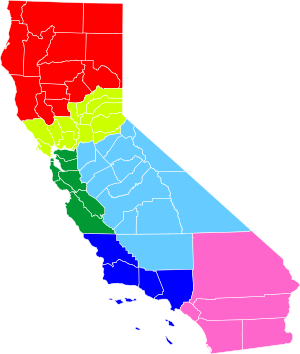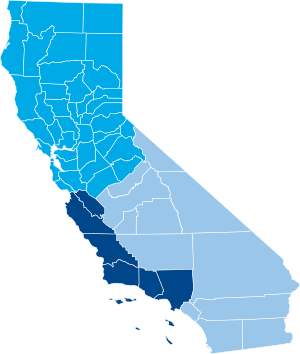Six Californias facts for kids
Six Californias was a plan to split the U.S. state of California into six new states. This idea was proposed as an initiative, which is a way for citizens to suggest new laws or changes to the state's rules. However, the plan did not get enough support to be voted on in the 2016 state elections.
A person named Tim Draper, who invests in new businesses (a venture capitalist), started this idea in December 2013. He spent a lot of money, over $5 million, trying to get the plan on the ballot. If the plan had passed, California would not have split right away. Both the California State Legislature (California's lawmakers) and the U.S. Congress (the U.S. national lawmakers) would have needed to agree to create the new states.
The plan would have created states named Jefferson, North California, Silicon Valley, Central California, West California, and South California. Tim Draper said he wanted to split California because he thought the state was too big to govern well. He believed smaller states would have better and more efficient governments.
People who were against the plan said it would waste money and resources to create new governments. Critics also thought it was a way to separate richer areas from poorer ones. They also believed it was an attempt to make California less supportive of the Democratic Party, as California is known as a "blue state" (meaning it usually votes for Democrats).
Contents
Why States Split: A Look Back
The U.S. Constitution has rules about how new states can join the country. It says that no new state can be made from part of another state without the original state's permission and the permission of Congress.
Some states have split in the past:
- Vermont became a state in 1791. It was created from land that New York also claimed.
- Kentucky separated from Virginia in 1792. Virginia's lawmakers agreed to this split.
- Tennessee was formed in 1796 from land that North Carolina gave to the U.S. government.
- Part of Alabama was once land given by Georgia.
Two splits happened because of slavery:
- Maine separated from Massachusetts in 1820. This helped keep a balance between states that allowed slavery and states that did not.
- West Virginia became a separate state in 1863 during the American Civil War. It broke away from Virginia because Virginia joined the Confederate States.
California has had many ideas to divide it into multiple states. More than 220 plans have been suggested! Some of these plans wanted to create a "State of Jefferson" in northern California and southern Oregon.
Getting on the Ballot
The "Six Californias" idea was started by Tim Draper in December 2013. To get the plan on the ballot for people to vote on, supporters needed to collect many signatures from registered voters.
In February 2014, officials allowed Draper to start collecting signatures. They needed to gather enough valid signatures by July 18, 2014. As the deadline got closer, Draper thought about waiting until 2016 to give people more time to learn about the plan.
On July 14, Draper announced they had collected 1.3 million signatures. This seemed like enough to get on the ballot. However, on September 12, 2014, state election officials checked a sample of the signatures. They found that only about 752,685 signatures were valid. This was not enough to qualify the plan for the ballot.
To get on the ballot, at least 807,615 valid signatures were needed. The campaign said they would check the signatures that were thought to be invalid.
Some people against the plan complained about how signatures were collected. They said that some people gathering signatures told voters that signing would be "opposing" the split, which was the opposite of what the petition actually did.
What the Plan Proposed
The "Six Californias" plan described how the state's 58 counties would be divided among the six new states. It also set up steps for the state government to prepare for the split. For the plan to work, voters in California, the Congress of the United States, and the California State Legislature would all need to approve it.
Proposed States and Their Areas
Here's how the plan would have divided California:
| Proposed state | Estimated population |
|---|---|
| Jefferson | 949,409 |
| North California | 3,820,438 |
| Silicon Valley | 6,828,617 |
| Central California | 4,232,419 |
| West California | 11,563,717 |
| South California | 10,809,997 |
Jefferson
The state of Jefferson would have been in the far northern part of California, near Oregon. It would have included fourteen counties: Butte, Colusa, Del Norte, Glenn, Humboldt, Lake, Lassen, Mendocino, Modoc, Plumas, Shasta, Siskiyou, Tehama, and Trinity. This plan for Jefferson did not include any land from Oregon, unlike some older ideas.
North California
North California would have been south of Jefferson, stretching from the Pacific Ocean to Nevada. It would have had thirteen counties: Amador, El Dorado, Marin, Napa, Nevada, Placer, Sacramento, Sierra, Solano, Sonoma, Sutter, Yolo, and Yuba.
Silicon Valley
The state of Silicon Valley would have been along the coast, from San Francisco to Monterey. It would have included eight counties: Alameda, Contra Costa, Monterey, San Benito, San Francisco, San Mateo, Santa Clara, and Santa Cruz.
Central California
The state of Central California would have been located between Silicon Valley and Nevada. It would have included fourteen counties, mostly in the middle of the state: Alpine, Calaveras, Fresno, Inyo, Kern, Kings, Madera, Mariposa, Merced, Mono, San Joaquin, Stanislaus, Tulare, and Tuolumne.
West California
West California would have been south of Silicon Valley and Central California. It would have included four counties: Los Angeles, San Luis Obispo, Santa Barbara, and Ventura.
South California
The state of South California would have been the southernmost part of the state, next to Mexico and Arizona. It would have included five counties: Imperial, Orange, Riverside, San Bernardino, and San Diego.
How the Split Would Happen
The plan allowed counties near the proposed borders to choose which new state they wanted to join. This would depend on a vote by the county's citizens and approval from its local government.
A group of 24 commissioners would have been chosen to figure out how to divide California's money and debts among the new states. The plan also said that the Governor of California would have to send the state-splitting proposal to Congress by January 1, 2018.
Why People Supported and Opposed It
Support for the Idea
Tim Draper believed that California was too big to be governed well. He felt that the state's lawmakers couldn't keep up with the problems in all of California's different regions, like creating jobs, improving education, and dealing with housing and transportation. He thought that splitting the state would create smaller governments that would be closer to the people they served.
Opposition to the Idea
A group called OneCalifornia was formed to oppose the "Six Californias" plan. They argued that the idea was hurting California's image in the world economy. They said it would be a huge waste of money and time, creating a lot of paperwork and duplicating government offices. They also worried it would make it harder for businesses in California.
Critics also said the plan was mainly a way for rich areas, like Silicon Valley, to gain more political power and control over their money. They believed it would separate California's higher-income communities from lower-income areas.
Some experts thought the plan would never pass Congress. They pointed out that creating five new states would greatly change the political balance in the U.S. Senate. Many Democrats in California's Congress were against the idea, while Republicans were divided. Opponents also argued that voters might not want to pay the high cost of setting up six new state governments and five new capitals.
Another Try: Cal 3
Tim Draper tried again to split California in August 2017. This new plan was called "Division of California into Three States," but it's often known as Cal 3. On June 13, 2018, it was announced that this plan had collected enough valid signatures to be put to a vote in November 2018. However, in July 2018, the California Supreme Court stopped it from being on the ballot. They wanted to review it further to make sure it followed the state's constitution.



